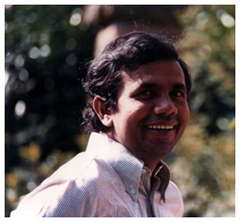Prof. Bopearachchi holds a B.A. from the University of Kelaniya (Sri Lanka), and a B.A. honours, M.A., M.Phil., and Ph.D. from the Paris 1 Sorbonne University, and a Higher Doctorate (Habilitation) from the Paris 4 Sorbonne University. After obtaining his doctorate from the University of Paris I - Sorbonne in June 17 1987, Bopearachchi initiated a comprehensive survey of pre-Sasanian coins held in museums worldwide. In the early 1990s, he began documenting and publishing the coins, thousands of which, along with hundreds of manuscripts, were then flooding the bazaars of Pakistan from war-ravaged Afghanistan. As he attempted to link numismatics with sculptural and pictorial iconography he developed a deep interest in the study of the art and archaeology of ancient India. This has led to his many publications and activities in the field.
More recently, his books on Gandhāran art, based on unpublished or partially published sculptures and objects from Gandhāra and Greater Gandhāra, draw on research carried out in museums in India, Pakistan, Afghanistan, Japan, Europe, Canada, and the United States, as well as fieldwork at ancient sites in India, Pakistan, Afghanistan, and Uzbekistan. These projects were made possible owing to the generous support of the Trung Lam Research Fund for Central Asian Art and Archaeology, the Center for Buddhist Studies at the University of California, Berkeley, where Bopearachchi is former Adjunct Professor of Central and South Asian Art, Archaeology, and Numismatics, and former Numata Visiting Professor of Buddhist Studies.
As Director of the French-Sri Lankan Archaeological Mission, Bopearachchi launched joint projects with the Center for Buddhist Studies at the University of California, Berkeley, focusing on Sri Lanka’s role in ancient maritime trade in the Indian Ocean. These projects include archaeological excavations; using GIS mapping software to discover spatial and temporal patterns in the relationship between Buddhism and maritime trade; and a study of how the stories of the life of the historical Buddha and of his previous lives (jātakas) found in Pāli Buddhist texts are illustrated in Kandyan period murals in Sri Lanka.
Among his numerous publications are 16 books, 156 articles, 6 exhibition catalogues, and edited 7 volumes; he is also a principal collaborator on numerous audio-visual projects and museum and archaeological databases. He has read 115 papers at international colloquia; delivered 345 talks in 182 universities, museums and associations all over the world, and has carried out archaeological missions in 30 different countries. The French Academy of Inscriptions and Belles-Lettres has honored five of his books with prestigious awards, including the distinguished George Perrot Medal for From Bactria to Taprobane: Selected Works of Osmund BopearachchiI, vols. I and II (2015). In 2006 the French government honored his career achievements with the L'ordre des Palmes Académiques (“Order of Academic Palms”). In 2024 he was elected to the French Academy of Inscriptions and Belles Lettres as Corresponding Member.
Abstract
The maritime trade is not limited to exchange of goods alone. In the ancient world deprived of passenger ships, cargoes were the only mode of transportation in the Indian Ocean. Not only traders, but also Buddhist monks, nuns, philosophers, artists and diplomats as well travelled together; and as a result, not only goods, but also philosophical thoughts and iconographies were exchanged. As a result, Buddhist iconographies developed in a cross-fertilized context, ingenuously incorporating the sentiments and aesthetics of their respective populations. Instead of reproducing stereotypical prototypes, they created new forms of art leaving some traces of the aspirations of the donor-traders, enabling us to understand the growth of the maritime networks.
"Yamakaprātihārya or the ‘Twin Miracle’: Where, when, why and how the Buddha mesmerized his friends and enemies”. This presentation, held at Stanford University on March 21, 2024, is part of the Ho Center's T. T. & W. F. Chao Buddhist Art & Film Series.
Les événements importants liés à la vie du Bouddha Gautama ne sont pas représentés de manière cohérente dans les anciennes écoles d'art d'Asie du Sud et du Sud-Est, et son éveil représenté sur la bannière de l'ancienne collection Adhémard Leclère au Musée des Beaux-arts et de la dentelle d'Alençon, suscite la controverse. Cette communication démontre que cette controverse est due à la confusion et à l'irrégularité de la façon dont les événements liés à la vie du Bouddha sont relatés dans les textes sacrés.

Date of Birth : 4th December 1949
Place of Birth : Negambo, Sri Lanka
Citizenship at birth : Sri Lankan
http://www.archeo.ens.fr/Osmund-BOPEARACHCHI.html
https://fr.wikipedia.org/wiki/Osmund_Bopearachchi
https://creops.sorbonne-universite.fr/bopearachchi-osmund/
https://www.youtube.com/watch?v=-jL0ZFFz5so
https://www.youtube.com/watch?v=wN7c2W7bpJ8
https://cnrs.academia.edu/OsmundBopearachchi
https://archive.org/details/Osmund_Bopearachichi
https://www.youtube.com/watch?v=5KQj4ini_hE
45 rue d’Ulm, 75005 Paris, France.
Telephone :(33 - 1) 44 - 32- 37-82
Fax :(33 - 1) 44 32 30 60.
